#exploring Christian unity
Explore tagged Tumblr posts
Text
Experiencing Oneness with God: A Deeper Look at John 14:20
Introduction: In Christian teaching, we often emphasize the unique relationship between Jesus and God the Father. Jesus, as the Son of God, is understood to have a special connection with the Divine—a connection that many Christians see as exclusive to Him. Yet, when we look closely at Jesus’ own words, we find something even more profound: an invitation to share in this divine relationship, to…
#2 Peter 1:4 meaning#biblical oneness#Christian faith deepening.#Christian Meditation#Christian oneness#Christian spirituality#Christian unity#deeper relationship with God#divine nature#exploring Christian unity#Jesus and God#Jesus is one with God#Jesus teachings#John 14:20 explained#oneness with God#participating in divine nature#Spiritual Transformation#unity in Christ#unity in Christianity#unity with the Father
0 notes
Text
From Study to Experience: My Transition from Seeking Solutions to Embarking on my Eternal Spiritual Journey
I grew up in the Southern Baptist Christian heritage. I was at church whenever the doors were open. From the teachings I absorbed, it became clear that learning and living the faith were considered primary, while external human experiences were secondary. The teachings led me to believe that to grow in my faith, I needed to study the Bible, grow closer to the Evangelical Christian God, and share His gospel.
During my teenage years and mid-20s, my life was unlike that of most young adults. Instead of parties and outings, I spent most of my time in my basement bedroom, engrossed in studying God's word and listening to sermons. I remember the countless hours spent pouring over the Bible; my only company was the soft glow of my dimmed bedroom lights and the quiet hum of the house around me.
Then, I attended Moody Bible College, a hub of diverse ideas, many of which contradicted each other. The college is nestled in the heart of Chicago, a city known for its diversity yet marked by segregation, making the college a microcosm of the city itself. I vividly recall the heated debates in theology class and the passionate discussions that filled the dorm rooms late into the night. The diversity of thought was so vast that one professor even believed another was destined for hell.
Having been exposed to a multitude of ideas and beliefs at the college and in the city, I left with an excitement to apply the teachings from Moody to further grow in my faith.
After leaving college, I embarked on a mission to find the truth among the teachings I had encountered at Moody. Christianity encourages its followers to seek the faith, and that’s exactly what I, as an individual, was finally doing. All denominations started with someone seeking a truth that may have been different from the teachings of their past. Martin Luther is a prime example of this.
I’m not claiming to be a reformer of Christianity. I’m merely pointing out that there are many examples of individual faith leaders and laypeople seeking a different outlook on faith within the umbrella of evangelical Christianity. My goal wasn’t to create a new outlook. Instead, I was trying to find a denomination that I believed was closest to what I perceived as the true faith. Just as some people may hop from church to church, I was denomination hopping.
This journey led me to a broader interpretation of the beliefs I had grown up with. I remember the day it hit me, like a sudden explosion, that I had discovered a deeper understanding of my spiritual heritage. This understanding was something that those in my life might view as heresy. Yet, there was absolutely no way I could forget about the peace and understanding that I found, a peace and understanding that extended beyond my Southern Baptist heritage.
Embracing this new understanding, I found a peace that harmonized with the teachings I had grown up with. This peace became a beacon, guiding me forward. I remember the feeling of liberation, of stepping into the unknown, guided by a deep inner conviction.
In the midst of my spiritual journey, I discovered Unity Spiritual Centers and "A Course in Miracles" (ACIM). These teachings resonated with me and felt like a natural progression of my spiritual growth, enriching my understanding of spirituality.
Unity Spiritual Centers, like the Southern Baptist tradition, emphasize the importance of a personal relationship with the Divine. However, Unity takes a more inclusive approach, embracing spiritual seekers of all faiths. It focuses on the oneness of all people and places emphasis on our inner similarities rather than our outer differences.
ACIM offered a fresh perspective on concepts I was familiar with. It teaches that love is our natural state and forgiveness is a tool to remove the barriers we've built against love. This was a profound shift from the teachings I grew up with.
ACIM presents a unique approach to the healing of human suffering. It provides a pathway out of our suffering through the disciplined practice of love and forgiveness. It teaches that Divine is pure, unbounded, unconditional love. We, like the Divine, are also limitless, bodiless spiritual beings. ACIM introduces the concept of non-dualism, suggesting that we are not separate from the Divine or each other. It also reinterprets some of the teachings of traditional Christianity.
My new understanding, shaped by Unity Spiritual Centers and ACIM, is a deepening and expansion of my original Southern Baptist beliefs. Both Unity and ACIM emphasize love and forgiveness, concepts that are central to Christianity as well. However, they introduce new perspectives that encourage personal growth and a deeper understanding of these concepts.
They teach me that love is not just something I receive from the Divine, but something that I am. Forgiveness is not just an act of pardoning others, but a process of releasing my own guilt and grievances.
These teachings have helped me reconcile the peace I discovered with my spiritual upbringing. They have not negated my original beliefs, but have built upon them, providing me with a broader understanding of spirituality.
So, while my path has grown and evolved, they are not a departure from the traditional Southern Baptist way. Instead, it’s a journey towards the same ultimate goal: a deeper understanding of the Divine, a closer relationship with the Divine, and a greater sense of inner peace.
Throughout my life, I’ve come to understand that there isn’t a problem requiring a studied solution. Instead, life is a divine journey waiting to be experienced. This journey offers opportunities to embrace love, extend forgiveness, and realize our oneness with all.
I’ve also learned that we should build upon and cherish our past experiences and knowledge learned, rather than hiding from, degrading, or rejecting them. The past experiences and knowledge learned are valuable lessons that guide us towards the peace and understanding our souls yearn for.
This encapsulates the essence of my experience - a shift from merely studying to truly experiencing the spiritual journey.
I will leave you with this prayer: May we all find inner peace and encounter peace every day, everywhere. May we all cultivate love and respect for everyone, regardless of their attitudes, mindsets, beliefs, and lifestyle choices.
Someday, this prayer will resonate with all - those in higher consciousness, those on earth, and those in lower consciousness. Every voice will acknowledge the Divine Light within us, not just glorifying a single entity, but the universal Oneness of the Divine, which is the source of our shared identity and unity. This will then manifest across all existence, leading us to return to the source of our shared Divine existence.
May your journey continue in unity, embracing love, extending forgiveness, and realizing our oneness with all. Until we meet again in this setting or in person, keep shining your Divine Light.
Fine Print: While writing this, I used an AI tool to help organize my thoughts and improve the structure of my writing. However, the ideas, beliefs, and messages conveyed are entirely my own. The AI simply helped me present them in a more coherent and effective manner.
#spiritual journey#faith#Christianity#southern baptist#unity spiritual centers#ACIM#religious explorations#personal growth#forgiveness#love#non dualism#moody bible college#inner peace#religion#spirituality#denomination hopping
0 notes
Text
Reality shifting
Demystifying the basics:
In order to have a better grasp of the concept of shifting, we must address the beliefs that brought us here in the first place.
Shifting got really popular on TikTok in 2020 (thank you DracoTok) and with it, misinformation came a plenty. So let's deconstruct the notion, pull it apart, and make it as simple as we can.
What is reality shifting?
To shift is to become aware of a different reality.
That's it. That's all there is to it.
Like changing the channel or flipping through the radio, all of creation is finished and all of the possible realities that you could potentially think of already exist. All you have to do is switch your awareness from one to the other.
But how did we get here? How do we do it? CAN we do it?
Well, let's see:
In order to believe in shifting in the first place, you have to at least be a little bit spiritual. And if that's the case, then ask yourself this:
Do you believe that you are the universe having a human experience? That you are the creator and the creation?
If the answer is yes, then you have a grasp of the basics.
You see, there is no fundamental separation between you and the universe. You are not a separate entity from the Cosmos.
You are the Cosmos.
This idea is not new. It is not some new age spiritual BS that sprouted into existence a few decades ago. It is an ancient philosophical and spiritual belief spanning back decades. Hinduism, Buddhism, and Taoism emphasize the concept of Atman (the soul) being identical to Brahman (the ultimate reality), suggesting a unity of consciousness. Many mystical traditions, from Sufism to Christian mysticism, have explored the idea of divine consciousness within the human being. Contemporary spiritual movements often incorporate this concept, emphasizing personal transformation and connection to a higher power.
In simple terms, you are all that there is, all that there was, and all that there will ever be.
So if you answered no to my previous question, read this again and tell me your thoughts.
Now that we got the basic concept out of the way, let's talk about shifting, other realities, and your moral compass.
If you agreed that shifting is becoming aware of another reality that you already exist in, and if you're on board with the notion that you are the divine, the creator, the universe herself, what is actually stopping you from shifting?
Nothing.
Nothing is standing in your way, nothing is blocking you from shifting. There is no more work to be done, no more attempts to fail, no more research to explore. All you have to do is let go. Release this hold that perfection, stress, and eagerness have on you, breathe in and know that you have already shifted.
It is done.
You are successful.
In the same vein, if you are completely and utterly convinced that you are the universe, you are all there is and all there will be, you are everything and nothing, what makes you so sure that your current form is your true one?
If you believe in reincarnation then you know that you have had many faces, many bodies, many races, many ages, many lives, many experiences...
Same with shifting. This reality is not the metric in which you measure someone's righteousness. It is not the one and only form in which you are stuck within forever. You are the creator, and you, as you experience yourself, already are all of the ages, all of the faces, all of the genders and the races and the ethnicities and the creations around you. You are the rock and the house and the cat and the butterfly. You are the mean neighbor who constantly complains and the little girl skipping rope on your driveway. You are the bus driver who is always grumpy and the old lady at the market who always smiles when she sees you. You are the dictator causing havoc and the victim suffering from oppression. You are both the bad and the good, because that is the essence of your experience. You are me, I am you. We are the one consciousness.
Morality is by no means subjective, but it is also your creation. You made the rules and you enforced them and you rebelled against them. You are the one and only.
So why measure someone's morality by where or who they decide to shift to? Why judge their existence and believe yourself superior for adhering to a set of rules you created? Nothing is set in stone and no two people shift to the same exact reality, so why hinder yourself? Why limit your experience?
Do you have any idea how lucky you are to know about shifting in the first place?
There are currently 8 billion people at this point in time in this reality, and you happen to be among the very few who are aware of such wonderful experience, of such divine knowledge. Are you really going to spend that time judging other people's choice of reality? And on the other hand, are you really going to let other people dictate, police, and limit your experience?
At the end of it all, we all go back to the same origin.
The one great consciousness, where there is no judgement, no superiority or inferiority complex, no finger pointing and virtue signaling. We simply exist.
Have fun on your shifting journey, know that your experience is yours and that you decide how it goes.
Be a good person, live your best lives, and spread love as much as you can ❤️
#law of assumption#reality shifting#shiftblr#loassumption#shifting community#shifting realities#desired reality#reality shift#shifting#shifting blog#shifters#spiritualgrowth#spiritual awakening#spirituality
478 notes
·
View notes
Text
Kwanzaa:

Kwanzaa, an annual holiday celebrated primarily in the United States from December 26 to January 1, emphasizes the importance of pan-African family and social values. It was devised in 1966 by Maulana Karenga, Inspired by Africa’s harvest celebrations, he decided to develop a nonreligious holiday that would stress the importance of family and community while giving African Americans an opportunity to explore their African identities. Kwanzaa arose from the black nationalist movement of the 1960s and was created to help African Americans reconnect with their African cultural and historical heritage. The holiday honors African American people, their struggles in the United States, their heritage, and their culture. Kwanzaa's practices and symbolism are deeply rooted in African traditions and emphasize community, family, and cultural pride. It's a time for reflection, celebration, and the nurturing of cultural identity within the African American community.
Kwanzaa is a blend of various African cultures, reflecting the experience of many African Americans who cannot trace their exact origins; thus, it is not specific to any one African culture or region. The inclusiveness of Kwanzaa allows for a broader celebration of African heritage and identity.
Karenga created Kwanzaa during the aftermath of the Watts riots as a non-Christian, specifically African-American, holiday. His goal was to give black people an alternative to Christmas and an opportunity to celebrate themselves and their history, rather than imitating the practices of the dominant society. The name Kwanzaa derives from the Swahili phrase "matunda ya kwanza," meaning "first fruits," and is based on African harvest festival traditions from various parts of West and Southeast Africa. The holiday was first celebrated in 1966.
Each day of Kwanzaa is dedicated to one of the seven principles (Nguzo Saba), which are central values of African culture that contribute to building and reinforcing community among African Americans. These principles include Umoja (Unity), Kujichagulia (Self-Determination), Ujima (Collective Work and Responsibility), Ujamaa (Cooperative Economics), Nia (Purpose), Kuumba (Creativity), and Imani (Faith). Each family celebrates Kwanzaa in its own way, but Celebrations often include songs, dances, African drums, storytelling, poetry readings, and a large traditional meal. The holiday concludes with a communal feast called Karamu, usually held on the sixth day.
Kwanzaa is more than just a celebration; it's a spiritual journey to heal, explore, and learn from African heritage. The holiday emphasizes the importance of community and the role of children, who are considered seed bearers of cultural values and practices for the next generation. Kwanzaa is not just a holiday; it's a period of introspection and celebration of African-American identity and culture, allowing for a deeper understanding and appreciation of ancestral roots. This celebration is a testament to the resilience and enduring spirit of the African-American community.
"Kwanzaa," Encyclopaedia Britannica, last modified December 23, 2023, https://www.britannica.com/topic/Kwanzaa.
"Kwanzaa - Meaning, Candles & Principles," HISTORY, accessed December 25, 2023, https://www.history.com/topics/holidays/kwanzaa-history.
"Kwanzaa," Wikipedia, last modified December 25, 2023, https://en.wikipedia.org/wiki/Kwanzaa.
"Kwanzaa," National Museum of African American History and Culture, accessed December 25, 2023, https://nmaahc.si.edu/explore/stories/kwanzaa.
"The First Kwanzaa," HISTORY.com, accessed December 25, 2023, https://www.history.com/this-day-in-history/the-first-kwanzaa.
My Daily Kwanzaa, blog, accessed December 25, 2023, https://mydailykwanzaa.wordpress.com.
Maulana Karenga, Kwanzaa: A Celebration of Family, Community and Culture (Los Angeles, CA: University of Sankore Press, 1998), ISBN 0-943412-21-8.
"Kente Cloth," African Journey, Project Exploration, accessed December 25, 2023, https://projectexploration.org.
Expert Village, "Kwanzaa Traditions & Customs: Kwanzaa Symbols," YouTube video, accessed December 25, 2023, [Link to the specific YouTube video]. (Note: The exact URL for the YouTube video is needed for a complete citation).
"Official Kwanzaa Website," accessed December 25, 2023, https://www.officialkwanzaawebsite.org/index.html.
Michelle, Lavanda. "Let's Talk Kwanzaa: Unwrapping the Good Vibes." Lavanda Michelle, December 13, 2023. https://lavandamichelle.com/2023/12/13/lets-talk-kwanzaa-unwrapping-the-good-vibes/.
901 notes
·
View notes
Text





The geometry of the Borromean Rings
Borromean rings are a captivating geometric structure composed of three interlinked rings. What makes them unique is their interdependency; if any one ring is removed, the entire structure collapses. This fascinating property, known as "Brunnian" linkage, means that no two rings are directly linked, yet all three are inseparable as a group. This intricate dance of unity and fragility offers a profound insight into the nature of interconnected systems, both in mathematics and beyond.
Borromean Rings and Mathematical Knots
Borromean rings also find a significant place in the study of mathematical knots, a field dedicated to understanding how loops and tangles can be organized and categorized. The intricate relationship among the rings provides a rich visual and conceptual tool for mathematicians. Knot theorists use these rings to explore properties of space, topology, and the ways in which complex systems can be both resilient and fragile. The visual representation of Borromean rings in knot theory not only aids in mathematical comprehension but also enhances our appreciation of their symmetrical beauty and profound interconnectedness.
Symbolism and Divinity in Borromean Rings
Throughout history, Borromean rings have been imbued with symbolic significance, often associated with divinity and the concept of the trinity. In Christianity, they serve as a powerful visual metaphor for the Holy Trinity – the Father, the Son, and the Holy Spirit – illustrating how three distinct entities can form a single, inseparable divine essence. This symbol is not confined to Christianity alone; many other cultures and religions see the interconnected rings as representations of unity, interdependence, and the intricate balance of the cosmos.
Borromean Rings as a Metaphor for Illusory Reality
Beyond their mathematical and symbolic significance, Borromean rings offer a profound metaphor for the nature of reality itself. They illustrate how interconnectedness can create the illusion of a solid, stable structure. This resonates with philosophical and spiritual notions that reality, as perceived, is a complex web of interdependent elements, each contributing to an overarching illusion of solidity and permanence. In this way, the Borromean rings challenge us to reconsider the nature of existence and the interconnectedness of all things.
#geometrymatters#geometry#cognition#reality#perception#structure#architecture#religion#science#philosophy#research#borromean#symbolism
99 notes
·
View notes
Photo
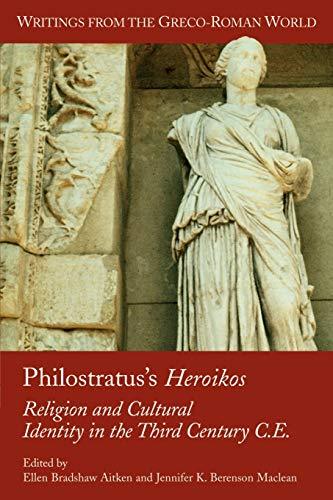
Philostratus's Heroikos: Religion And Cultural Identity In The Third Century C.E.
Philostratus’s "Heroikos," composed by a leading figure of the Second Sophistic movement, presents a rich and intricate literary dialogue that encapsulates the cultural, religious, and political currents of the Roman Empire during the Severan era. Framed as a conversation between a Greek vinedresser and a Phoenician merchant, the work not only advocates for the veneration of Greek hero cults but also integrates the role of ethnicity in shaping Roman identity.
Philostratus’s Heroikos, composed during the flourishing of the Second Sophistic, stands as a deeply layered literary and cultural artifact of the Roman Empire in the Severan period. Aitken and Maclean’s edition, Philostratus’s Heroikos: Religion and Cultural Identity in the Third Century C.E., provides a meticulously annotated translation and a compelling introduction that positions the dialogue as a site for negotiating religious tradition, ethnic identity, and imperial ideology.
Structured as a dialogue between a Greek vinedresser and a Phoenician merchant, Heroikos explores the continued relevance of Greek hero cults and their function in the religious and cultural life of the Roman East. As the vinedresser recounts visions and revelations received from the hero Protesilaos, the skeptical Phoenician becomes gradually transformed—both intellectually and spiritually—into a devotee of Hellenic values and traditions. This narrative arc, as the editors argue, functions not merely as a literary device, but as a symbolic representation of the assimilation of non-Greek identities into the dominant Greco-Roman cultural framework. The vinedresser’s role as cultural mediator underscores the text’s broader concern with the preservation and transmission of Greek heritage under Roman rule.
The two editors, an Associate Professor of Early Christian History and an Associate Professor of Religion, situate Heroikos in the reign of Alexander Severus (222–235 C.E.), a period marked by renewed interest in cultural consolidation amid increasing tensions along the eastern frontier. Within this context, Philostratus’s depiction of hero cults—particularly those involving Greek victories over Persian enemies—can be read as a subtle political allegory. As Aitken and Maclean note, the figure of the Phoenician merchant may reflect contemporary anxieties about ethnicity and loyalty in a Roman Empire governed by emperors of Syrian descent. The transformation of this character into a loyal adherent of Greek heroism aligns with Severan efforts to reassert a Hellenic cultural identity as a means of legitimizing imperial power.
Several contributors to the secondary literature deepen this reading. Alain Blomart’s work on the religious and political significance of hero cults contextualizes Heroikos within broader practices of sacred migration and cultic transfer. His analysis, though not limited to Philostratus, helps illuminate the veneration of Protesilaos as both a localized and politically resonant form of religious expression. Jeffrey Rusten, in his study of Heroikos's allusive narrative, explores Philostratus’s sophisticated engagement with classical texts, arguing that the dialogue’s literary authority is constructed through a complex web of references, revisions, and reinterpretations of Homeric myth.
Aitken’s article sharpens the political dimension of the dialogue, highlighting how ethnic stereotyping is employed to dramatize the cultural superiority of the Greek tradition. She interprets the Phoenician’s conversion as a narrative response to the challenge of governing a multicultural empire, particularly one in which Syrian elites held increasing prominence. This transformation serves not only as a literary resolution but as a symbolic affirmation of imperial unity under a Hellenized Roman identity.
Taken together, these readings—both within Aitken and Maclean’s edition and in the broader scholarly discourse—demonstrate the richness and complexity of Heroikos as a text deeply embedded in its historical moment. Far from being a mere exercise in nostalgic Hellenism, Philostratus’s dialogue emerges as a strategic intervention in contemporary debates about cultural authority, religious identity, and imperial legitimacy. The editors’ thoughtful translation and extensive commentary make this volume an invaluable resource for scholars of Roman imperial culture, Greek literature, and the religious transformations of late antiquity.
This translation offers a compelling lens through which to view the intersection of literature, religion, and politics in the Roman Empire. Through the vinedresser and the conversion of the Phoenician merchant, the text stages a vision of cultural integration that is both idealized and deeply implicated in the ideological currents of its time. This edition invites readers to engage with Heroikos not only as a literary dialogue but as a sophisticated commentary on the contested terrain of identity in the 3rd century C.E.
Read More
⇒ Philostratus's Heroikos: Religion And Cultural Identity In The Third Century C.E.
17 notes
·
View notes
Text
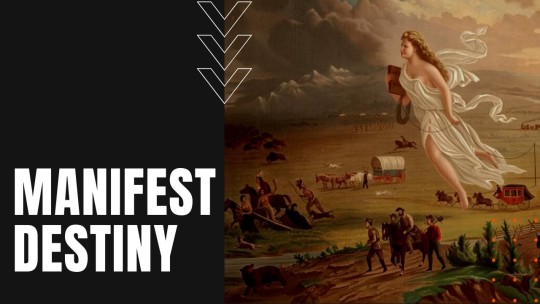
The term 'Sub-Saharan' Africa is a colonial language that was used to belittle African nations south of the Sahara and to separate the other countries from North Africa– Egypt, Morocco, Algeria, Tunisia, Libya, and Sudan due to them being Arab states.




Colored, Negro, Black, Nigger
Every one of these terms come from the mindset of Europeans not Africans. Indigenous African societies do not use the term black as a racial identity outside of influences brought by Western cultures.
Contemporary anthropologists and other scientists, while recognizing the reality of biological variation between different human populations, regard the concept of a unified, distinguishable "Black race" as socially constructed.
Black is a term developed in the Colonial Assembly of Maryland, after a rebellion called Bacon's Rebellion, fought from 1676 to 1677.
The alliance between European indentured servants and Africans (a mix of indentured, enslaved, and Free Negroes) disturbed the colonial upper class. They responded by hardening the racial caste of slavery in an attempt to divide the two races from subsequent united uprisings with the passage of the Virginia Slave Codes of 1705.
White took on the meaning "British, Christian and having rights. Black meaning not having rights.
These divided the two populations, by giving poor Europeans with no power, unprecedented power over all non-Europeans.
The laws were devised to establish a greater level of control over the rising African slave population of Virginia. It also socially segregated white colonists from black enslaved persons, making them disparate groups and hindering their ability to unite. Unity of the commoners was a perceived fear of the Virginia aristocracy, who wished to prevent repeated events such as Bacon's Rebellion, occurring 29 years prior.
By refusing to call you an African, it belittles you, no such thing as black names, black land or black languages. It is like calling a woman big lips or flat butt and refusing to call the woman by her actual name. "Hey colored girl, or black boy".
In social psychology, a stereotype is a generalized belief about a particular category of people.
African populations have the highest levels of genetic variation among all humans.


Why You Probably Shouldn't Say 'Eskimo'
People in many parts of the Arctic consider Eskimo a derogatory term because it was widely used by racist, non-native colonizers. Many people also thought it meant eater of raw meat, which connoted barbarism and violence. Although the word's exact etymology is unclear, mid-century anthropologists suggested that the word came from the Latin word excommunicati, meaning the excommunicated ones, because the native people of the Canadian Arctic were not Christian.

According to the Constitution of India, we are “the people of India that is Bharat”
In English language discourse, the word ‘India’ is used and in Hindi expressions, the word ‘Bharat’ is used. The Anglicised call it ‘India’, and the indigenous call it ‘Bharat’. Our ruling class calls it ‘India’, the others, the janata, call it ‘Bharat’. It has become a trend and fashion to prefer the word ‘India’ over ‘Bharat’. We converse with the country in Hindi and other vernaculars while we govern it in English.

Japanese people usually refer to their country as Nihon or Nippon
The name "Japan" in English is derived from the Portuguese word "Japão," which was used during the 16th century when Portuguese traders and explorers first arrived in Japan. The Portuguese term "Japão" likely evolved from the Malay word "Japang" or "Japang Pulau," which referred to the Japanese archipelago.
The Japanese people themselves refer to their country as "Nihon" (日本) or "Nippon" (日本), and these terms have been used in the Japanese language for centuries.

As European seen themselves as the elites of all races and god's chosen people. They took on the mindset of what I say makes the most sense.
Renaming essentially all populations they came in contact with, using their language as opposed to learning the language of the natives.
And whatever religion or spirituality people had Europeans demonized it and forced converted people to Christianity.
#african#afrakan#kemetic dreams#africans#brownskin#brown skin#afrakans#manifest destiny#colonization#colonialism#europeans#european#slavery#mindset#christianity#religion#spiritual#spirituality#asians#gujarat#gujarati people#india#bharat#nippon#nihon#english#eskimo#yupik#inuit#bacons rebellion
170 notes
·
View notes
Text
Sumeru's war on Nietzsche (part 1)
One of the main themes of the Sumeru chapter is the victory of altruistic values over egoism, specifically the egoism in Friedrich Nietzsche's philosophy.
I want to point out these connections so we can agree from the getgo on Nietzsche’s presence in the chapter:
Kaveh defeats nihilism in Parade of Providence, and the defeat of nihilism is one of the main goals of Nietzsche's philosophy
Achievements in the Khvaena of Good and Evil quest are named after Nietzsche quotes
Sumeru is mostly inspired by India, Iran and Egypt, and Nietzsche had a bone to pick with the philosophical influence of all three in the west
The themes of egoism and altruism are explored through the work of western philosophers and the philosophy of eastern religions, following the real life historical interrelation of both. And because the outcome of this confrontation favors altruism more, I also think it can be interpreted as a rejection of western values of individualism as a whole.
Nietzsche has the leading role for this analysis for clarity's sake (or else it'd end up in 15k words) but the philosophical material used in the region is vast and varied.
Egyptian influence
Nietzsche blamed Egypt for influencing Greek philosophers like Plato (public enemy #1 of Nietzsche) in his conception of goodness. Philosophers of ancient Greece would go on to influence western philosophy and institutions.
Nietzsche thought that developing the idea of objective goodness which one should aspire to and be governed by is where the ancient Greeks went wrong as a society, disrupting the balance between the rational values of the god Apollo and the frenzy of the god Dionysus that made ancient Greece an ideal society in Nietzsche's eyes. The clash of order and chaos is what made Greek culture rich in his opinion, so introducing a code of ethics ruined the dichotomy.
This concern with goodness was of course Plato's fault, who most likely was influenced by the Egyptian concept of Ma'at. Ma'at can basically be understood as a moral principle that guided both Egyptian society in its religious beliefs and its institutions.
In Genshin Cyno’s character is inspired by the god Anubis and one of his main motifs is the scales, his personal drive is also the pursuit of justice and order. This is likely because in Egyptian mythology Anubis weighs the hearts of the deceased against the feather of Ma'at.
So here we have the character inspired by Egyptian culture who personifies the ancient concept of morality that Nietzsche blamed for ruining a society he considered advanced.
Indian influence
The philosopher Arthur Schopenhauer was initially Nietzsche's role model, but he'd later become his biggest critic due to the ideas promoted by his philosophical system.
Schopenhauer borrowed elements from dharmic religions (Buddhism and Hinduism) to construct his ideas, mainly the concept of Brahma (a universal consciousness which originated all creation and it therefore presents the world as a unity) and the concept of desires as the basis of suffering (therefore desires have to be suppressed).
Nietzsche considered this philosophical approach to be pessimistic, arguing that it easily led into nihilism. He thought similarly about Buddhism (although he held it in higher regard than Christianity) for being a religion that denies the self and devalues the world, only considering it a transitory illusion that had to be escaped. Nietzsche aimed for the complete opposite: giving value to the world as it was and indulging in one's own individuality, independent from collective constraints.
In Genshin I think the concept of Brahma is close to the plot of the sovereign dragon Apep, who creates life that later goes back to it in Nahida's second story quest. Buddhist philosophy is covered in Wanderer's arc, which I analysed here.
Iranian influence
Iran and India share common ancestors, so their religious practices also have common traditions (such as the worship of nature), hence why they largely make up most of Sumeru’s inspiration. The ancient religion of Iran is called Zoroastrianism, things like the Akademiya darshans and the House of Daena are named after its religious principles, as well as the overall region where the quest Khvaena of Good and Evil takes place.
Zoroastrianism was founded by Zoroaster, who conceptualized the world as a conflict between good (originated by the creator god Ahura Mazda) and evil (influenced by the entity Ahriman) where humans have free will to choose between the two.
This cosmology would later influence the abrahamic religions (Judaism, Christianity and Islam) and, in Nietzsche's view, originate the western perception of morality he was critical of.
He used the prophet Zoroaster (known in Germany as Zarathustra) as his own character in the book Thus Spoke Zarathustra to voice his ideas of a new kind of man that could overcome this morality that Europe had submitted to under the authority of Christianity. This way, since Zoroaster was the one to introduce morality to the western world, so would he be the one to denounce it.
Historical context
The philosophical confrontation between egoism and altruism began in the aftermath of the French revolution, when European countries formed into republics. The threats of democracy, liberalism and socialism loomed over the aristocratic class and the societal status quo, which produced reactionary responses in the shape of individualism and egoism: the exaltation of the individual over the collective majority.
Nietzsche himself took part in (and built his ideas around) this reactionary response, he argued that the purpose of society was producing culture, which could only be achieved by the subjugation of one class to support the elites who could produce the art that the inferior class was supposedly incapable of producing. He denounced democracy, the egalitarian cause of liberalism and the class equality of socialism of attempting against this purpose, and he used the altruistic values of religion as a scapegoat that collectively addressed the three.
Nietzsche's philosophy
In this sense, Christianity was a method of control to suppress the individual from the basis of resentment —here's where the master and slave morality dichotomy he authored comes from: the subjugated class, in his theory, motivated by feelings of resentment and powerlessness against the elites, would develop values of humility, altruism and collectivism in order to morally place themselves above the “masters”.
For Nietzsche, this dominating morality was limiting and produced no worthy culture or arts, and without a purpose society was doomed to fall into nihilism (a state of being devoid of meaning). He identified the pessimistic approach of eastern religion (like the influence they had on Schopenhauer) and the slave morality of western religion as the culprits of nihilism, as well as the conformity of the “last man” (as he called it) who didn't aspire to anything beyond what was imposed on him.
Nietzsche's main existential problem with religion was the devaluation of the world and the individual, treating both as transitory towards a “beyond” where value was placed instead (Nirvana in Buddhism, Heaven in Christianity, etc), and he sought to return this value to life through the concept of the ubermensch (“overman” or “superman”): a man who would embrace existence as it is and redefine the values of society beyond morality with his own independent and individual values.
So, to summarize, Nietzsche “blamed” Greek philosophy (which was influenced by Egyptian morality) and Zoroastrianism (the ancient religion of Iran) for the Christian dominating morality of Europe, as well as eastern dharmic religion for influencing western philosophy and leading society into nihilism. In his view, religion (and its morality) was a method of control that had to be overcome to return value to the individual.
The setting of the Akademiya
The Akademiya's original Chinese name is Sumeru Institute of Religious Decree, which means it acts as a religious institution that treats religion and education as one and the same. This church of knowledge also grants power to its elite class (formed on the basis of academic merit) who rules the nation as an extension of the god of wisdom.
The Akademiya plays three roles of authority at the same time: spiritual, educational and political, all three which serve as a means to control and shape the values of the population. The Akademiya decides which knowledge has worth and which material is allowed to be learned, it decides which faith in which god has value or is allowed to be practiced, and it decides who occupies positions of political authority and who can access the education necessary for class mobility.
In short, the Akademiya is a form of governance that has the power to define and limit the values of society: its rules, beliefs, morals, ethics, hopes and even its dreams.
However, unlike Nietzsche's assessment, it's egoist values that dominate Sumeru under the Akademiya's guidance.
The culture of the Akademiya separates people into the ordinary and the extraordinary, those who live in submission and those who stand out. There is no community between scholars, only associations where each party must benefit for the duration of the projects they collaborate in, then they are terminated.

"Relationships are merely a byproduct in this exchange of interests. They may be pleasant and captivating, but they can only ever be secondary. When scholars collaborate to solve difficult problems, we freely share our knowledge and resources with one another, as if we were all kin. However, this collaboration ends after the results of our work are published. The reason is simple: We are scholars, and there are new projects that await our attention."
This type of association described in Nilou's story quest seems very similar to Max Stirner’s Union of Egoists, an idea he proposed as an antithesis to communal society where individuals conceptualized each other as “property” that either has or doesn't have use in one's life.
As Paul Thomas summarized, Stirner believed that “we should aspire not to the chimera of community but to our own “one-sidedness” and combine with others simply in order to multiply our own powers and only for the duration of a given task.”
Egoism and God
Max Stirner was the first philosopher to publish work on egoism with The Ego and Its Own in 1844, his influence on Nietzsche is contended due to the similarities in the foundation of their ideas.
It was Stirner who first presented the concept of the death of god, meaning that society could no longer hold on to religious beliefs disproved by the scientific advancements of the Enlightenment. Nietzsche would later coin the phrase “god is dead”, and both identify man as the killer, although Stirner argued that the god of religion had been replaced by the god of humanistic values and Nietzsche proposed for man to become god himself.
Here's Stirner's quote (The Ego and Its Own, 1844):
At the entrance of the modern time stands the "God-man." At its exit will only the God in the God-man evaporate? And can the God-man really die if only the God in him dies? They did not think of this question, and thought they were through when in our days they brought to a victorious end the work of the Illumination, the vanquishing of God: they did not notice that Man has killed God in order to become now—”sole God on high." The other world outside us is indeed brushed away, and the great undertaking of the Illuminators completed; but the other world in us has become a new heaven and calls us forth to renewed heaven-storming: God has had to give place, yet not to us, but to—Man. How can you believe that the God-man is dead before the Man in him, besides the God, is dead?
Here's Nietzsche's quote (The Gay Science, 1882):
God is dead. God remains dead. And we have killed him. How shall we comfort ourselves, the murderers of all murderers? What was holiest and mightiest of all that the world has yet owned has bled to death under our knives: who will wipe this blood off us? What water is there for us to clean ourselves? What festivals of atonement, what sacred games shall we have to invent? Is not the greatness of this deed too great for us? Must we ourselves not become gods simply to appear worthy of it?
Both likely drew from the work of Ludwig Feuerbach on religion as a projection of human ideals into divine attributes. For example, omnipotence reflects human desire for control and power, while omniscience reflects human thirst for knowledge and aspiration to overcome ignorance.
Sumeru’s ubermensch
The plot of the Sumeru chapter presents a nation in the aftermath of the death of their god, Lord Rukkhadevata. The political class struggles to accept the new god left in her place, as she's far from representing the ideals of wisdom they aspire to project on their archon, and thus fails to provide meaning for scholars’ quest for knowledge.

The sages then set out to manufacture an artificial god with their collective human wisdom, a projection of themselves in the vessel of a god, transcending all established ethical (and moral) boundaries.
The vessel for this artificial god has his own motivations, which in the fairy tale that stores his memories it's depicted as such:
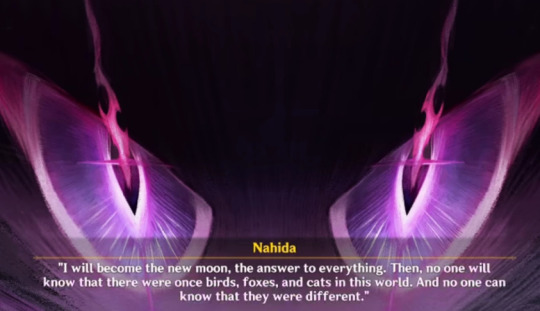
They essentially create an artificial ubermensch capable of redefining values, but the real ubermensch is found behind the artificial god itself.
Crime and punishment
Nietzsche called Fyodor Dostoevsky the only psychologist he had anything to learn from, as he was deeply influenced by the psychology of his novels —of which he read botched translations that didn't quite transmit the author's philosophy, but still.
The novel Crime and Punishment has a protagonist that represents the opposite of the author's beliefs, who happens to be quite similar to Nietzsche's idea of the ubermensch or the higher man. This character justifies his crime (a murder) to himself arguing that people are divided into the ordinary and the extraordinary, and the extraordinary have the right to commit crimes if it allows them to put forward their extraordinary contributions to the world.
From Crime and Punishment:
“Ordinary men have to live in submission and have no right to transgress the law, because, don't you see, they are ordinary. But extraordinary men have a right to commit any crime and transgress the law in any way, just because they are extraordinary.”
“...if the discoveries of Kepler and Newton could not have been made known except by sacrificing the lives of one, a dozen, a hundred, or more men, Newton would have had the right, would indeed have been in duty bound…to eliminate the dozen or the hundred men for the sake of making his discoveries known to the whole of humanity. But it does not follow from that that Newton had a right to murder people left and right to steal every day in the market.”
The protagonist sees himself as an extraordinary man, therefore, his murder is justified in contribution made to the world in exchange.
For Nietzsche, who sees life conditioned on the dominance over the life of others, a criminal is a man whose primordial human impulses to exercise power, which in the ordinary men have been suppressed by the dominating morality, have found an unconventional outlet through crime. Thus, a criminal is a symptom of a sick society that has domesticated itself out of its own nature.
The criminal as a glorified outcast, a rebel against modern society whose abhorrent behavior is a healthy instinct that denotes potential —at least symbolically, he wasn't calling out to people to commit crimes per se.
While Dostoevsky wrote the protagonist of his novel to struggle with guilt in the form of an illness and allowed him to find salvation in facing punishment for his crime, Nietzsche holds the criminal in high regard, seeing guilt as something beneath him.
This archetype is popular in media with characters like Hannibal Lecter, and indeed, many fans of the game expected Alhaitham or Scaramouche to fulfill it, but the character that truly embodies the outcast genius is The Doctor.

Dottore commits crimes against others to carry out his plans, never feeling guilt or shame. He was expelled from the Akademiya precisely for violating the ethical code all scholars are governed by and, as Nietzsche's ubermensch, aims to redefine the values of the world by collaborating with the Tsaritsa to “burn the old world.”
However, Dottore is the antagonist of the chapter, and the attempt at manufacturing the artificial god is depicted as an act of hubris, not a brave crusade against the restraining morality of religion. Furthermore, both the sages and Scaramouche face punishment (in their own way), something Nietzsche would disapprove of in an appropriate higher man.
Looking back on the Akademiya, the scholars seem to suffer under the culture of egoism and competition so well established in the institution.
They're often disoriented in their life, contrasting with the villagers who know themselves and their place in the world.
And the god the sages had dismissed as unworthy is reinstalled as the archon, maintaining the institution as it was while taking down the Akasha, the method of control of the sages.
Nietzsche’s egoism is rejected by the narrative, it raises and it falls in the course of the chapter, but what does this mean for the region?
Part 2 will examine how the narrative engages with the philosophies of altruism and how both egoism and altruism converge in the characters of Alhaitham and Kaveh
#sumeru#long post#genshin lore#posted some weeks ago and meant to cross post here the two parts together but i dont think its gonna be written in quite a while#main post
23 notes
·
View notes
Text
Religion in the work of Frantz Fanon
Dr. Frantz Fanon, was a great inspiration for me and his way of maintaining free thoughts even though he often credited the Black Church for having meetings to inspire Black Unity worldwide but what he disliked about religion is how it was used as a weapon to destroy Black Africans and Black Indigenous People's lives by colonization and slavery.
Fanon talked a lot about Black on Black Love being the greatest force of Black Rebellion and Black Liberation but he also advised that achieving this through the lens of religion was impossible in regards to the Christian faith but saw the more radical approach under the faith of Islam and the ability for Islam to be a powerful force towards achieving Black Rebellion and Black Liberation.
6 notes
·
View notes
Text

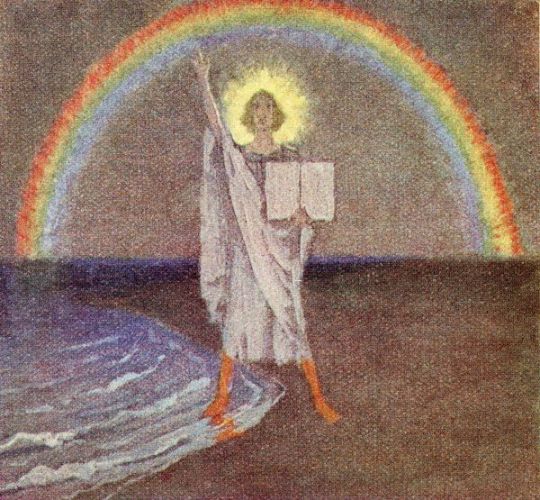

The Soul's Divine Origins and Fall into Duality
According to esoteric Christian thought, the human soul has its origins in the divine realm, having been created in the image and likeness of God (Genesis 1:27). This means that, at its core, the soul is a direct emanation of the divine essence. However, the soul, through its fall into the material world, has forgotten its divine origins and become ensnared in the illusion of separation and duality.
The Soul as a Divine Spark
In esoteric Christianity, the soul is seen as containing within it a divine spark, sometimes referred to as the imago Dei (the image of God). This spark is the innermost essence of the soul, the point at which the soul is directly connected to God. It is the uncreated, eternal aspect of our being, untouched by sin, death, or the limitations of the material world.
However, while the divine spark remains pure, the outer layers of the soul become clouded by ignorance and attachment to the ego. The journey of spiritual awakening is the process of removing these layers of illusion so that the divine light within can shine forth fully.
The Fall into Duality and Separation
The "fall" of the soul is a metaphysical concept that refers to the soul’s descent into the realm of duality. In this state, the soul becomes identified with the ego—the false self that sees itself as separate from God and others. The ego is rooted in fear, desire, and a sense of lack, always seeking fulfillment in external things rather than in the divine presence within.
In the esoteric Christian tradition, this fall is not viewed as a punishment but as a necessary stage in the soul's evolution. The descent into the material world and the experience of duality allow the soul to learn, grow, and ultimately return to God with a deeper understanding of divine love and unity.
The Path of Return
The central task of the spiritual seeker in esoteric Christianity is to return to the original state of unity with God. This path of return is often called the "mystical ascent" or "spiritual journey." Through practices such as prayer, meditation, contemplation, and inner purification, the soul begins to awaken from its slumber in the material world and ascend through the layers of reality, back to its source in the divine.
This journey is symbolized in many Christian mystical texts by the image of the ladder, the ascent of the mountain, or the journey through the wilderness. It is a gradual process of transformation, where the soul moves from a state of ignorance and separation to one of divine union and illumination.
As we continue this exploration, we will build on these foundational principles, examining how the seeker can move through the stages of purification, illumination, and ultimately, divine union.
#studyblr#christian faith#christian blog#religion#christianity#religionblr#esoteric#actually autistic#christian mysticism#esoterist#gnosticism#gnostic christianity#gnostic teachings#gnostic gospels#gospel#christian quotes#christian living#christian study#bible study#study#study motivation#religious imagery#religious
14 notes
·
View notes
Text
Some historical relativists overemphasise the subjective in history at the expense of the material. Subjective factors certainly do affect obviously objective developments. In the Hellenistic Age, for example, Heron reputedly designed steam engines, yet so far as we know they were never used to replace human labor, as they were two thousand years later. Subjective historians, to be sure, would emphasise the subjective factors in this fact. But what interaction between ideological and material factors explains why one society — capitalism — used the steam engine on a vast scale for the manufacture of commodities, while another — Hellenistic society — used it merely to open temple doors for the purposes of mass mystification? Overly subjectivistic historians would do well to explore not only how different traditions and sensibilities yielded these disparate uses of machines but what material as well as broadly social factors either fostered or produced them.
Other historical relativists are nominalistic, overemphasising the idiosyncratic in History, often begging basic questions that must be explored. A small group of people in ancient Judea, we may be told, formulated a localised, ethnically based body of monotheistic beliefs that at a chronologically later point became the basis of the Judeo-Christian world religion. Are these two events unrelated? Was their conjunction a mere accident? To conceive this vast development in a nominalistic way, without probing into why the Roman emperors adopted the Judeo-Christian synthesis — in an empire composed of very different cultures and languages that was direly in need of ideological unity to prevent its complete collapse — is to produce confusion rather than clarity.
- Murray Bookchin, History, Civilisation, and Progress: Outline for a Criticism of Modern Relativism
24 notes
·
View notes
Text
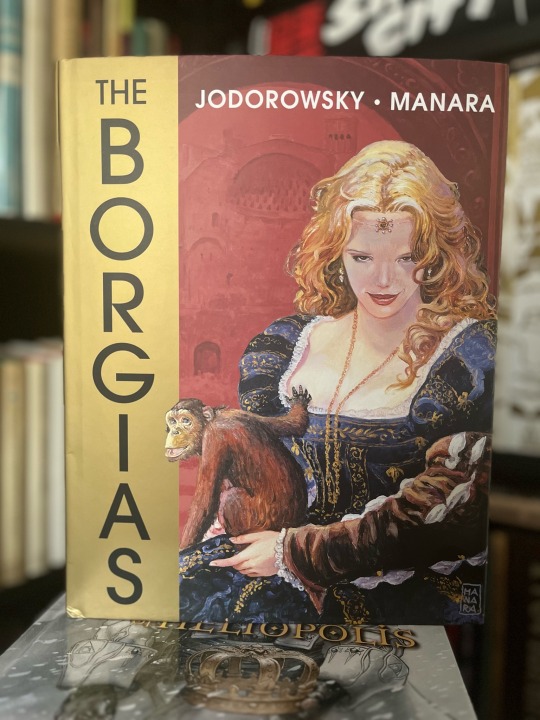
“THE BORGIAS AND THE MAFIA
In 1455, the Holy See was occupied by Alfonso de Borja, a descendant of this eighth knight, under the name Callixtus III. Having gained the trust of King Alfonso Il of Naples, he came to power at the age of seventy-seven, while suffering from stomach cancer. His pain made him suspicious. He believed only in the loyalty of his Spanish family. Through the legacy of inheritance, his fortune fell into the hands of Rodrigo Borgia, who used it to fund his own ascension to the papal throne. Thus was born the first Mafia clan in history.
The Borgias possessed an absolute thirst for power. Europe had, by then, lost all hope in the goodness of God: the plague known as the Black Death had made miserably clear just how precarious human life can be, and with the bitterness of an orphan deprived of its supreme father, the populace consoled itself by indulging in carnal pleasures. It was in this context that Rodrigo Borgia, now Pope Alexander VI, began trafficking in a very powerful drug: papal bulls, which granted the forgiveness of sins . . . Every citizen could murder, steal, gamble, engage in prostitution or incest or unbridled gluttony, and all without fear: because in exchange for a handful of ducats, the Church offered absolution and the assurance that God would welcome the sinner into heaven.
The Borgias' passion for life, for dominance over all mankind, their disdain of any divine retribution, this absolute lack of morality, offset by their staggering appreciation of fine art, utterly captivated me. Knowing that the respectable Church of today once had a Spanish adventurer at its roots, a clever thief who was surrounded by his bought-and-sold lovers and by his children, each embodying a spiritual summit as well as an abyss - Cesare, strength and tyranny; Lucrezia, beauty and lust; Giovanni, intelligence and vanity; Gioffre, purity and stupidity - reminded me of the lotus plant, whose bright flowers spring from filthy swamps . . . And so I yielded to the temptation to write a comics script: in the form of a vast historical fresco on the creation, growth, and death of this provocative family, so similar to some of the people currently governing our planet.
(…)
In place of the Black Death, we have cancer and AIDS, along with pollution of our air, our water, and our planet. Instead of cities at war, we are witness to entire countries fighting. Christianity and Islam remain in conflict even today. The discovery of the Americas has now become interplanetary exploration. We're experiencing the artistic revolution of the Renaissance through personal computers and the Internet. The papal bulls of yore are today's commercial "benedictions" from the United States. Just as the ducat was the key to paradise during the Renaissance years, our only God is the almighty dollar: whether its value goes up or down and the gates of heaven open or close . . . Just as Machiavelli, in his book The Prince, recommended aggressive invasions to achieve Italian unity, in this day and age a powerful nation (that shall remain nameless) ruthlessly attacks any country, claiming to obstruct "Evil" but spurred on, in fact, by its thirst for oil . . . Today, the Borgias have been replaced by oil mafias, pharmaceutical industry multinationals, drug cartels, and greedy bankers.
And yet, the corruption that flourished during the Renaissance could not prevent the emergence of a Leonardo da Vinci, a Raphael, a Botticelli, a Michelangelo, a Dante, a Machiavelli even, as well as so many others who opened up new vistas to human awareness. This is what brings us great hope: the possibility that the decadence of the world today is just the pain of a chrysalis becoming a butterfly, and that from the last vast crisis into which we plummet a new humanity will arise, one that will look upon us with the same tender compassion we feel for the monkeys.
—Alejandro Jodorowsky
August 2011”
#jodorowsky#alejandro jodorowsky#manara#milo manara#borgia#borgias#graphic novel#comic books#dark horse#papacy#pope#Italy#renaissance#machiavelli
122 notes
·
View notes
Text
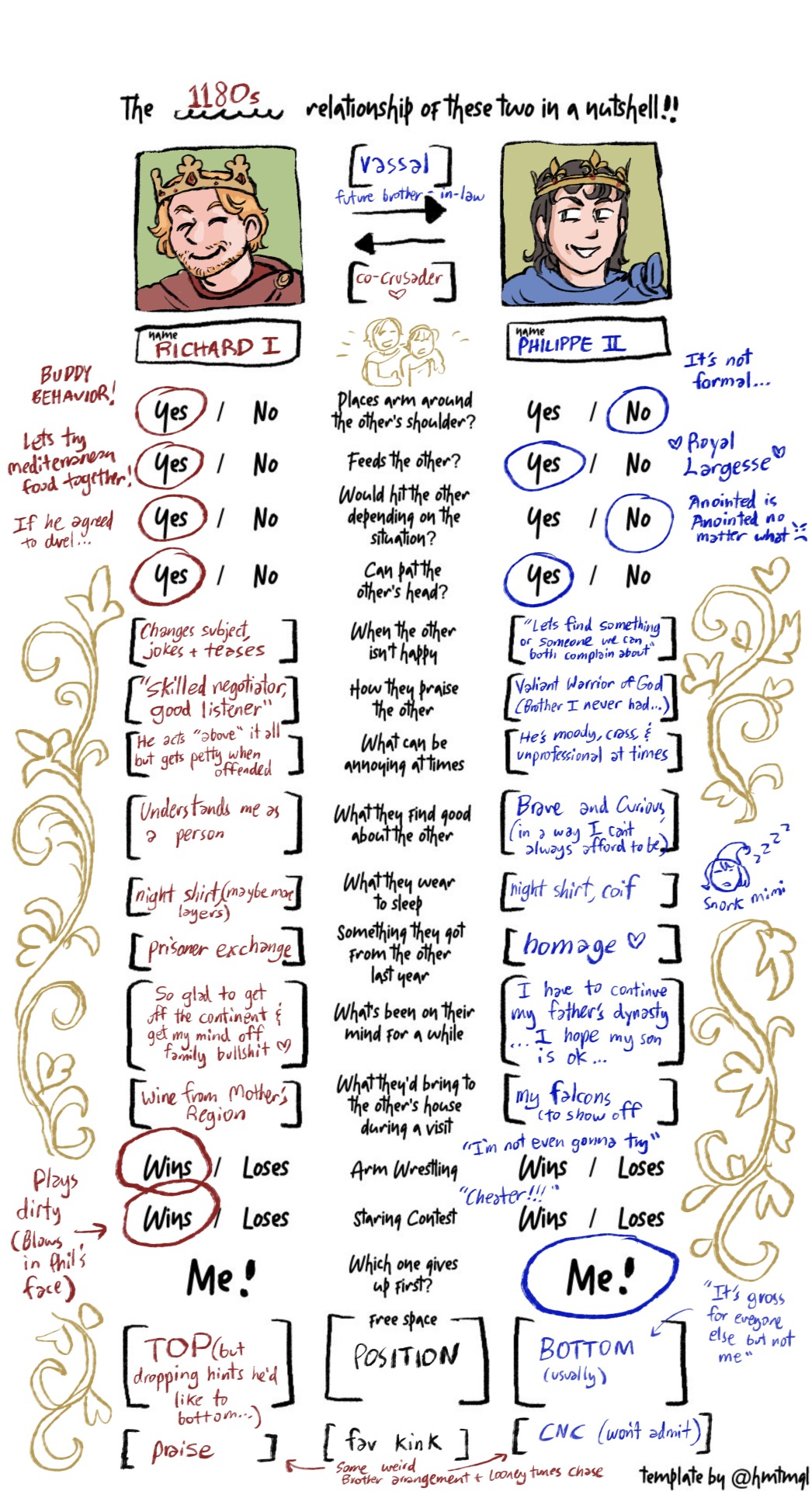
I filled out this shipping meme from here which was a lot of fun! had to think a bit about some sections, since usually I like exploring the part of their relationship where they’re already dissolving and backstabbing. I set in the pre-crusade era which is when things were mostly cordial (although there was still lots of conflict regarding Toulouse and how that was handled), so hopes and dreams of Christian Unity(tm) are still at least floating on the surface…
It’s kind of nice to think about how for more toxic ships (irl and fiction) the things people think positively about each other also end up becoming the biggest frustrations. Also the position section is just my headcanon and preferences ofc, i have a lot more thoughts about that and how I make it work in my RPF internal logics but this is a good summary of my stuff
35 notes
·
View notes
Text
From Jonkanoo To Jingle Bells

https://www.sharonfoxart.com/shop/ -Link to the artist's other paintings
Jonkanoo, a word that used to mean something. Now, it's just an experience that we can only live through our parents’ hazy childhood memories. Always resembling a strange folk tale that’s told just for the sake of retelling it. Pitchy Patchy and the rest of the characters running and dancing wildly all over the streets on Christmas. Creating a blur of bright strips of colours as they create mischief. Children giggling and screaming when the performers got too close. And the hypnotic beat of the drum pulsating within you, tempting you to dance along.
I didn’t know if I could believe my mother’s story until I started studying History in primary school. Then we had to reenact the Jonkanoo with our barely accurate costumes, not for the significance of culture, but just so that our skit would get a decent grade. Then it was goodbye to our ripped-up cloths and makeshift masks, immediately dumping them in the garbage without a second thought. Much like the tradition itself. Trashed and forgotten. But why has Jonkanoo become a thing of the past? Why have we made it a thing of the past? Surely, there can’t be any justification good enough for its abandonment. We traded Jonkanoo to Jingle Bells in a heartbeat, and all for a fat chubby man that “sees us when we’re sleeping and knows when we’re awake”. And sure, I enjoy Christmas just as much as the next person. But why must it come at the cost of our culture? Therefore, the question I wish to explore is, how did Christmas come to dominate what was once a loved tradition, silencing Jonkanoo forever?
Jonkanoo traces its origins to the 18th century, born out of the residence of the enslaved Africans in Jamaica. It became a celebration of identity, which they were given permission to celebrate only on Christmas. Performers donned vibrant costumes, representning iconic characters such as Pitchy-Patchy, Horsehead and Devil, all while energetic music poured from goatskin drums and cowbell. It wasn't just a festival, but it also became a spectacle of unity, cultural expression and defiance. A living testament of our traditions and the creativity of our ancestors. But as Jamaica modernized, so did our tastes for traditions. So while Christmas grew into a monster, being fed by its parent consumerism, Junkanoo barely managed to maintain its relevance, eventually having to be satisfied with only being spotted in the images of our History textbooks.
For many Jamaicans, Jonkanoo's decline is indicative of how much of our culture is slipping away from us. “At this rate, we'll have nothing to offer the future”, says Lexi Smith, a college student. “Our traditions are meant to be shared and practiced”. Others, however, see the shift as a sort of evolution that has happened for the better. “Jonkanoo isn't very Christian anyways”, says Miss Tate. “Christmas brings families together and carries a much better message than Jonkanoo. I'm quite fine if it doesn't come back”.
Ultimately, I don't think we have to choose between Jonkanoo and Christmas, but rather, there should be efforts to revive Jonkanoo and find a way for both to coexist. I mean, just imagine a Christmas where we integrated the vibrant energy of Jonkanoo with the warmth and generosity of Christmas. And the sad part is, making this a reality isn't dependent on the difficulty to plan such an event, but rather, how much we care to execute it. Thus, as Christmas continues to dominate, as Jamaicans, we must decide whether we should let another tradition slip out of our grasp and create further cracks in our culture. Jonkanoo may have been silenced, but its spirit still lingers somewhere where we left it, along with the costumes and the masks that all call out to its people. The question is: How long will it take us to answer the call?
#writers on tumblr#writers and poets#witers on tumblr#writeblr#writing#creative writing#art#artists on tumblr#jamaica#history
7 notes
·
View notes
Note
i think that the headcanon about ink being jewish (coded?) is a very interesting one because it can bring a lot of discussions about religion coding in utdr.
you see, religion IS a thing in deltarune/undertale. the monster religion that appears in deltarune is heavily based on christian pratices, like, the existence of a church and the "toriel goes to church every sunday"; monster kid wearing a cross necklace; toriel is reffered as being religious in the wiki; "May the Angel lighten your path" phrase from Father Alvin and 'Christmas' being very often reffered to). although, their religion does lack the whole deal with sins and confessions (as said by Father Alvin) which means that it isn't literally Christianity, although heavily based on it.
now, i've indeed seen people compare Ink's belief in the creators as being a bit religious coded due to the whole "creator" kind of deal and based on my knowledge about a certain amount of religions, his outlook on life does give me jewish vibes. Ink believes in a single intenty (i know it's multiple people, but the concept of "the creators" is often presented as an unity) that is responsible in the creations of all beings and life, he's shown as being very respectful and strict over his beliefs and that everything goes according to a script. i think it's his whole vibe really, but i can't explain it all that well tbh lol
yes !!! to be fair I do think that it's purely Deltarune that has the religion coding (or really it is right there in the text)- Undertale does not have the same evidence or intent. But it is very clear for Deltarune!! There's literally a church!! A large part of the game involves "the angel's heaven" and not to mention all the devil coding that Gaster has going on. It's clear that we're meant to pick up on the small religious town feel. It's kinda how funny that I, the secular Jew, has so much headcanons on religion in the UTMV. In my own personal interpretation of the UTMV I've kinda gone wild on religion coding and exploring that angle. Even before I fell in love with the Jewish Ink headcanon, I already saw his relationship with the creators as religious in some way (at least, I think that's how a lot of the other characters would see it). I see Dream's belief in "The Balance" as something akin to religious as well. I've also played around with other possible religious-like beliefs that inhabitants of the multiverse might have, especially those who aware of the multiverse (what kinds of things would people believe in, in order to cope?). It's probably my anthropology loving brain but I always find that kind of worldbuilding to be the most captivating. I do think Ink's adherence to the script above all else is actually a trait that isn't particularly Jewish of him, or shouldn't be considered as such maybe (I'm not saying this goes against the headcanon. characters and people are multifaceted. it just irks me a bit to attribute that trait to a Jewish interpretation of his character). Because, in order to be so protective of the scripts, he has to let people die and suffer. One of the most important Jewish values is that life is of most importance. You are allowed, and it is actually an obligation, for you to break rules if it is to save a life. If you wanted to work this into a Jewish headcanon/interpretation of Ink- I think it would be really interesting to show his struggle with this. and this is where my DREAM IS ALSO JEWISH HEADCANON COMES IN WITH THE STEEL CHAIR!! I think Dream really can embody this obligation. He will save anybody no matter what. but anyway. thank you so much for the ask <3 I love getting to talk about this headcanon
7 notes
·
View notes
Text
it’s that time of year again
books finished in 2024:
Las Derechas: The Extreme Right in Argentina, Brazil, and Chile, 1890–1939 by Sandra McGee Deutsch (February 24)
Found this in the bibliographical essay of Paxton’s Anatomy. Vibrantly and readably traces the evolution of the far right in the ABC countries over three generations, from intellectual exploration to vague patriotic militias to fully-fledged fascist parties. Pays close attention to the roles of gender and class, and uses Stanley Payne and Ernst Nolte for a very solid treatment of fascism in part three.
Polish Politics in Transition: The Camp of National Unity and the Struggle for Power, 1935–1939 by Edward D. Wynot, Jr. (March 15)
Read Wynot both to learn more about the Polish fascist party Falanga and to explore Gregory Kasza’s concept of the kakushin or renovationist right, or ‘revolution from above’. Frequently felt dry, tedious, or even meandering but histories of bureaucratic squabbling might just always have a bit of that. It does contain interesting information about Falanga, along with a decent though undefined concept of fascism, and it is useful for dissecting the ‘guts’ of a renovationist regime.
The Golden Dawn’s ‘Nationalist Solution’: Explaining the Rise of the Far Right in Greece by Sofia Vasilopoulou and Daphne Halikiopoulou (May 27)
Started reading this initially as part of a research project on Golden Dawn. It’s short and often repetitive but actually very insightful, part of the authors’ larger research agenda of analyzing the Greek crisis as a fundamental crisis of regime legitimacy. Uses Roger Griffin and Michael Mann to integrate Golden Dawn into comparative fascist studies to a greater degree than anything else I’ve seen.
Who Were the Fascists? Social Roots of European Fascism edited by Stein U. Larsen, Bernt Hagtvet, and Jan P. Myklebust (June 29)
Gets cited all over the place, especially in work from the 1980s and ’90s; in particular it was Juan Linz’s chapter that motivated me to read. An absolutely mammoth collaboration attempting to unpack the socio-economic bases of interwar European fascist (and other authoritarian) parties and regimes; deeply imperfect but often deeply fascinating, probably best used like an encyclopedia. I have said before that fascist studies ought to recapture the spirit of this book because the cultural approach is getting a bit stale.
New Right versus Old Right & Other Essays by Greg Johnson (August 7)
Probably found on Johnson’s Wikipedia article to be honest. One of the most lucid and tolerable fascist authors I’ve read, though the bar is low and content warnings apply for white supremacy, antisemitism, and misogyny. In my opinion, required reading for understanding what the alt-right was and what they were trying to do, as well as the place of fascism in contemporary white nationalist thought.
Never Caught: The Washingtons’ Relentless Pursuit of Their Runaway Slave, Ona Judge by Erica Armstrong Dunbar (October 30)
Assigned for a class. Very approachable, actually almost to a degree that the writing feels like YA fiction but that probably isn’t fair. Impressively weaves a compelling story and a concrete sense of life for a black woman in the early republic out of very little documentary evidence, often having not just to read between lines but to juggle multiple alternative interpretations in places where we simply do not know.
The Old Christian Right: The Protestant Far Right from the Great Depression to the Cold War by Leo P. Ribuffo (December 27)
Not sure where I found it specifically, possibly Paxton’s Anatomy. A famously sharp and innovative intellectual history of the American far right through profiles of three key figures, contributing the concept of the “Brown Scare” and providing an early critique of ‘counter-extremism’ frameworks. To a degree Ribuffo does for the American right what the ‘new consensus’ did for fascist studies in attempting to take these people and their ideas ‘seriously’ through methodological empathy.
Domination and the Arts of Resistance: Hidden Transcripts by James C. Scott (December 30)
Also assigned for a class, which is funny since it’s the first anarchist theory I’ve read in ages. While self-admittedly schematic and groundwork-laying, Scott still manages an extraordinarily perceptive study of power relations and their impact on everyday life at a very granular level, especially those ‘quiet’ forms of resistance to oppression that often go unrecorded. Despite some partial disagreements, I do think probably everyone ought to read this.
8 notes
·
View notes